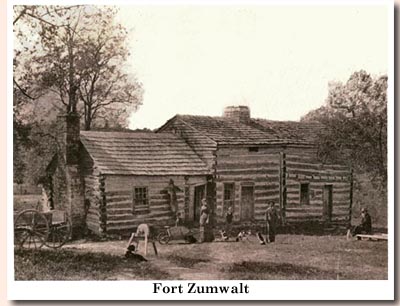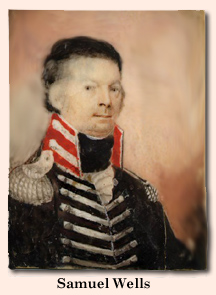
The presence of permanent non-Native American residents in what is today
O'Fallon can be substantiated as far back as 1796 when Jacob Zumwalt accepted Spanish land grant #55.
The land grant consisted of 450 arpents (383.8 acres) and was located on both sides of
Belleau Creek. Today's Fort Zumwalt Park sits on a portion of this original land grant.
The history of the Zumwalt family and their homestead fort is a microcosm of
American westward expansion and a tribute to the early settlers who came to the area in order to
create a better life for themselves and their families, a process which still continues to this day.
Jacob and his brother, Christopher Zumwalt, moved their immediate families first and five
additional Zumwalt brothers followed them later. Local legend has it that Daniel Boone
helped his friend, Jacob, locate his homestead at the brink of a hill that had a fresh spring below.
Zumwalt's Fort and Family Facts:
- Came from Pennsylvania, then to Kentucky, then to St. Charles County.
- Built the first hewn log house north of the Missouri River.
- With help from the extended family, the first section was completed in 1798; other additions
were made in succeeding years.
- Jacob helped brother Christopher build a mill and brother Adam operated a distillery.
Both were closer to the area that is now St. Paul.
- Four generously sized rooms, hewn log walls, a stone foundation, plank floors, a double
fireplace and other details of substantial Pennsylvania German construction set the house apart
from others.
- Zumwalt's Fort was one of the largest of its kind in St. Charles County at that time.
- Scene of the first Methodist sacrament in Missouri, administered by Rev. Jesse Walker in 1807.
- Became a "homestead fort" (residence centrally located and fortified to protect a number of
families) during the War of 1812.
- A total of seven settler forts were in St. Charles County; three were located in or near
O'Fallon. The other two being Pond Fort off Highway N in Dardenne Prairie, and White's
Fort in Dog Prairie (St. Paul area).
- As many as ten families found refuge during the hostilities which were characterized by quick
penetrating Indian raids against settlements along the Missouri and Mississippi Rivers.
- Fighting ended in Missouri by July 1815 when peace treaties were signed at nearby Portage
des Sioux.
- Jacob lived there for nineteen years, raised ten children from two wives and moved on to Pike
County, Missouri with one of his sons in 1817. He passed away three years later.

Legend has it that before the War of 1812, Black Hawk, a Sauk chief noted for his dignified manner,
regularly bought whiskey from Adam Zumwalt, who lived about six miles from Zumwalt's Fort, and danced
with his daughters. During the War of 1812, Black Hawk and a band of warriors fought U.S. Rangers
to a draw at the Battle of the Sinkhole in Lincoln County off present-day Highway 79 just north of
Old Monroe.
The War of 1812 ended with the Treaty of Ghent in 1814 and after the local treaties were signed with
the Native Americans at Portage des Sioux, it opened the floodgates to a tide of immigration from
the eastern states and Europe. For the next twenty years, virtually all westward
migration funneled through St. Charles and passed through present-day O'Fallon. The
settlers' homes were generally far apart and the mills and trading points were far apart as well.
Travel was tedious and a railroad had not yet entered the state. Since
the wooded areas of Missouri contained only Indian trails in the 1820's, it is easy to understand
why the settlers chose the path of least resistance - the river. Most of the Anglo-American
immigrants from Kentucky, Tennessee and Virginia traveled on a glorified raft called a flatboat to
their new homes. The early German immigrants usually found their way to this area by
way of either New York or New Orleans, through St. Louis and St. Charles in search of farmland
in this fertile area between the two great rivers. The earliest of the well-traveled
trails to reach what was to become O'Fallon was the Salt River Road. The road grew
from animal paths to an Indian trail made by those who collected salt from the evaporation of the
Salt River in north central Missouri. The original Salt River Road started on Boone's
Lick Road, one mile west of St. Charles, and extended through present-day St. Peters, O'Fallon, St.
Paul, and Flint Hill where it becomes present-day Highway 61.
The portion of the Salt
River Road that passes through O'Fallon is today named Highway P. Virtually all westward
migration passed through present-day O'Fallon via the Salt River Rd. and Dardenne Prairie over the
Boones' Lick Road, now called Highway N. There was also Mexico Road, which branched off
from the Salt Lick Road. Large parts of these early paths passed through areas that are
today within the O'Fallon city limits. People are still using these basic routes today
to travel within the county.
The Audrains, Wells and Heald Families:
As you trace the families that make up O'Fallon's history, you can see that many of them moved to
this area in fairly large groups. Some may have traversed together; others came weeks or months
apart giving the earliest arrivals time to set up camp.

- James H. Audrain and his father-in-law, Samuel Wells fought at the Battle of the Thames in
Ontario, Canada, in which legendary Shawnee leader, Tecumseh, was killed.
- Samuel Wells, Revolutionary War and War of 1812 veteran, left Kentucky for St. Charles County
in 1816.
- Wells eventually accumulated 2,350 acres in the area and served as judge and State
Representative.
- Samuel Wells' later marriage was to his son-in-law's sister, Margaret Audrain.
- His last years were spent on a smaller farm located at the present location of Weber's
Quarry.
- Colonel James H. Audrain and wife, Mary Elizabeth, daughter of Samuel Wells, moved their family
by flatboat to St. Charles County and Peruque Creek in 1816.
- The Audrains established a prosperous mill, distillery, and tavern at Peruque Creek and Salt
River Road (today Dames Park in O'Fallon) on 212 acres granted to Mary Elizabeth by her father,
Samuel Wells.

- In 1811, Rebekah Wells, daughter of Samuel, married Nathan Heald.
- Major Nathan Heald was commandant of Fort Dearborn, now Chicago, Illinois.
- Both Nathan and Rebekah were wounded during the War of 1812 at Ft. Dearborn.
- Nathan and Rebekah Heald came to O'Fallon in 1817 and purchased the
"Zumwalt Plantation." Major Heald never fully recovered from his wounds and died in
1832. Rebekah died in 1857.
- Heald property passed to the surviving son, Darius Heald, who built Stony Point, a two-story
brick farmhouse, on the property in the early-1880's.

|